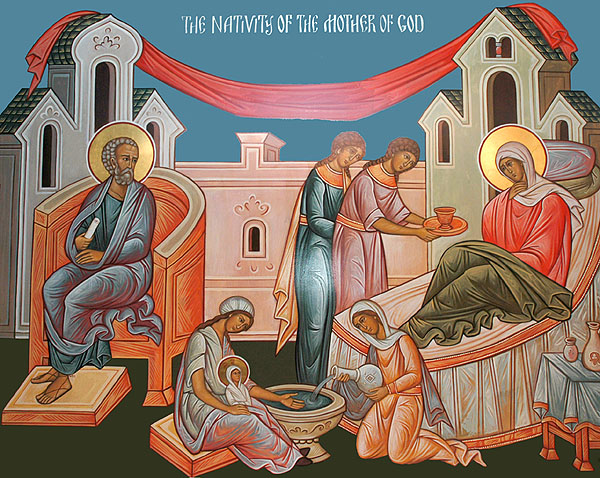Nativity of the Theotokos

In addition to the celebration of the Annunciation, there are three major feasts in the Church honoring Mary, the Theotokos. The first of these is the feast of her nativity which is kept on the eighth of September.
The record of the birth of Mary is not found in the Bible. The traditional account of the event is taken from the apocryphal writings which are not part of the New Testament scriptures. The traditional teaching which is celebrated in the hymns and verses of the festal liturgy is that Joachim and Anna were a pious Jewish couple who were among the small and faithful remnant—“the poor and the needy”—who were awaiting the promised messiah. The couple was old and childless. They prayed earnestly to the Lord for a child, since among the Jews barrenness was a sign of God’s disfavor. In answer to their prayers, and as the reward of their unwavering fidelity to God, the elderly couple was blessed with the child who was destined, because of her own personal goodness and holiness, to become the Mother of the Messiah-Christ.
Your nativity, O Virgin, has proclaimed joy to the whole universe. The Sun of Righteousness, Christ our God, has shone from you, O Theotokos. By annulling the curse he bestowed a blessing. By destroying death he has granted us eternal life (Troparion).
By your nativity, O most pure virgin, Joachim and Anna are freed from barrenness; Adam and Eve from the corruption of death. And we, your people, freed from the guilt of sin, celebrate and sing to you: The barren woman gives birth to the Theotokos, the Nourisher of our Life (Kontakion).
The fact that there is no Biblical verification of the facts of Mary’s birth is incidental to the meaning of the feast. Even if the actual background of the event as celebrated in the Church is questionable from an historical point of view, the divine meaning of it “for us men and for our salvation” is obvious. There had to be one born of human flesh and blood who would be spiritually capable of being the Mother of Christ, and she herself had to be born into the world of persons who were spiritually capable of being her parents.
The feast of the Nativity of the Theotokos, therefore, is a glorification of Mary’s birth, of Mary herself and of her righteous parents. It is a celebration as well of the very first preparation of the salvation of the world. For the “Vessel of Light,” the “Book of the Word of Life,” the “Door to the Orient,” the “Throne of Wisdom” is being prepared on earth by God Himself in the birth of the holy girl-child Mary.
The verses of the feast are filled with titles for Mary such as those in the quotations above. They are inspired by the message of the Bible, both the Old and New Testaments. The specific Biblical readings of the feast give indications of this.
At Vespers the three Old Testamental readings are “mariological” in their New Testamental interpretation. Thus, Jacob’s Ladder which unites heaven and earth and the place which is named “the house of God” and the “gate of heaven” (Gen 28.10–17) are taken, to indicate the union of God with men which is realized most fully and perfectly—both spiritually and physically—in Mary the Theotokos, Bearer of God. So also the vision of the temple with the “door ‘to the East’” perpetually closed and filled with the “glory of the Lord” symbolizes Mary, called in the hymns of the feast “the living temple of God filled with the divine Glory” (Ezek 43.27–44.4). Mary is also identified with the “house” which the Divine Wisdom has built for himself according to the reading from Proverbs 9.1–11.
The Gospel reading of Matins is the one read at all feasts of the Theotokos, the famous Magnificat from Saint Luke in which Mary says: “My soul magnifies the Lord and my spirit rejoices in God my Saviour, for he has regarded the low estate of his handmaiden, for behold, henceforth all generations will call me blessed” (Lk 1.47).
The epistle reading of the Divine Liturgy is the famous passage about the coming of the Son of God in “the form of a servant, being born in the likeness of man” (Phil 2.5–11) and the gospel reading is that which is always read for feasts of the Theotokos—the woman in the crowd glorifies the Mother of Jesus, and the Lord himself responds that the same blessedness which his mother receives is for all “who hear the word of God and keep it” (Lk 11.27–28).
Thus, on the feast of the Nativity of the Theotokos, as on all liturgical celebrations of Christ’s Mother, we proclaim and celebrate that through God’s graciousness to mankind every Christian receives what the Theotokos receives, the “great mercy” which is given to human persons because of Christ’s birth from the Virgin.
